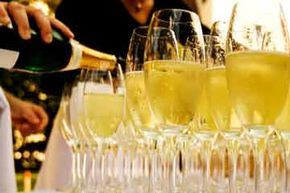When it comes to toasting a special event or occasion, everyone usually heads for the champagne. Sure, you can toast with wine, beer, cocktails or soda, but using the bubbly denotes that it's special. Most people call any kind of sparkling wine champagne, but true champagne comes from the region in France known for producing the best sparkling wines on Earth. The region, not surprisingly, is named Champagne. The climate, soil and strict production regulations in Champagne ensure that the quality of sparkling wine there is unmatched. Because of the delicate nature of champagne and the occasions where it's typically served, it requires a little more than plastic cups or beer mugs to do it right.
The Chill
Serving champagne at the proper temperature is essential. There are some different schools of thought and preferences, but generally speaking, champagne should be served at a temperature between 39 and 48 degrees Fahrenheit (4 to 9 degrees Celsius). Non-vintage and sweeter champagnes can take the lower side of that scale, but a fine champagne should hover between 43 and 46 degrees Fahrenheit (6 to 7 degrees Celsius). A wine refrigerator is the best way to get an exact temperature, but a couple of hours in a regular refrigerator should get you close to where you need to be. You can also fill a wine bucket with half ice and half water for a 30-minute rapid chill. Remember to always leave the bottle corked until it's time to serve.
Advertisement
The Flute
A beer mug or plastic cup might be an easier way to serve a drink to a roomful of people, but it isn't the preference when serving champagne. If you want to do it right, you'll want to splurge a little and use the tall, skinny and easily breakable flutes. The stem is long and they can be a bit precarious, but if it's just for a toast, you don't need to worry about your guests managing the delicate flute all night. If you don't have long-stemmed flutes, you can get away with a tulip-shaped wine glass. The reason champagne is served in a flute is because the design of the glass strengthens the aromas of the wine and aids the flow of bubbles, a key aspect of drinking sparkling wines. And while the bubbly is served chilled, champagne flutes should always remain at room temperature.
The Pour
After you've uncorked your champagne, which is best to do aimed away from people and glass, it's time for the pour. Champagne is extremely bubbly, and the last thing you want to do is pour it so that it flows over the glass and onto your guest. Start with just a little in the bottom and let the bubbles die down. Then fill the glass about two-thirds full with a steady, even pour.
Advertisement

